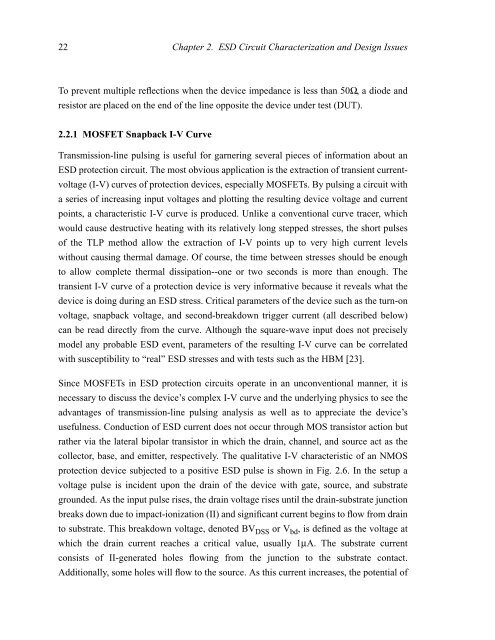characterization, modeling, and design of esd protection circuits
characterization, modeling, and design of esd protection circuits
characterization, modeling, and design of esd protection circuits
Create successful ePaper yourself
Turn your PDF publications into a flip-book with our unique Google optimized e-Paper software.
22 Chapter 2. ESD Circuit Characterization <strong>and</strong> Design Issues<br />
To prevent multiple reflections when the device impedance is less than 50Ω, a diode <strong>and</strong><br />
resistor are placed on the end <strong>of</strong> the line opposite the device under test (DUT).<br />
2.2.1 MOSFET Snapback I-V Curve<br />
Transmission-line pulsing is useful for garnering several pieces <strong>of</strong> information about an<br />
ESD <strong>protection</strong> circuit. The most obvious application is the extraction <strong>of</strong> transient currentvoltage<br />
(I-V) curves <strong>of</strong> <strong>protection</strong> devices, especially MOSFETs. By pulsing a circuit with<br />
a series <strong>of</strong> increasing input voltages <strong>and</strong> plotting the resulting device voltage <strong>and</strong> current<br />
points, a characteristic I-V curve is produced. Unlike a conventional curve tracer, which<br />
would cause destructive heating with its relatively long stepped stresses, the short pulses<br />
<strong>of</strong> the TLP method allow the extraction <strong>of</strong> I-V points up to very high current levels<br />
without causing thermal damage. Of course, the time between stresses should be enough<br />
to allow complete thermal dissipation--one or two seconds is more than enough. The<br />
transient I-V curve <strong>of</strong> a <strong>protection</strong> device is very informative because it reveals what the<br />
device is doing during an ESD stress. Critical parameters <strong>of</strong> the device such as the turn-on<br />
voltage, snapback voltage, <strong>and</strong> second-breakdown trigger current (all described below)<br />
can be read directly from the curve. Although the square-wave input does not precisely<br />
model any probable ESD event, parameters <strong>of</strong> the resulting I-V curve can be correlated<br />
with susceptibility to “real” ESD stresses <strong>and</strong> with tests such as the HBM [23].<br />
Since MOSFETs in ESD <strong>protection</strong> <strong>circuits</strong> operate in an unconventional manner, it is<br />
necessary to discuss the device’s complex I-V curve <strong>and</strong> the underlying physics to see the<br />
advantages <strong>of</strong> transmission-line pulsing analysis as well as to appreciate the device’s<br />
usefulness. Conduction <strong>of</strong> ESD current does not occur through MOS transistor action but<br />
rather via the lateral bipolar transistor in which the drain, channel, <strong>and</strong> source act as the<br />
collector, base, <strong>and</strong> emitter, respectively. The qualitative I-V characteristic <strong>of</strong> an NMOS<br />
<strong>protection</strong> device subjected to a positive ESD pulse is shown in Fig. 2.6. In the setup a<br />
voltage pulse is incident upon the drain <strong>of</strong> the device with gate, source, <strong>and</strong> substrate<br />
grounded. As the input pulse rises, the drain voltage rises until the drain-substrate junction<br />
breaks down due to impact-ionization (II) <strong>and</strong> significant current begins to flow from drain<br />
to substrate. This breakdown voltage, denoted BVDSS or Vbd , is defined as the voltage at<br />
which the drain current reaches a critical value, usually 1µA. The substrate current<br />
consists <strong>of</strong> II-generated holes flowing from the junction to the substrate contact.<br />
Additionally, some holes will flow to the source. As this current increases, the potential <strong>of</strong>
















